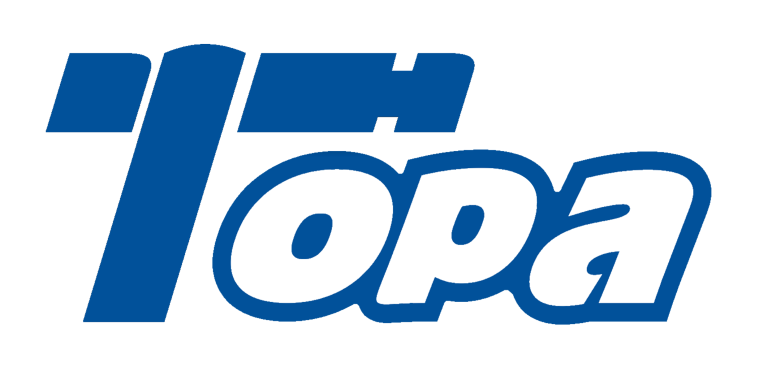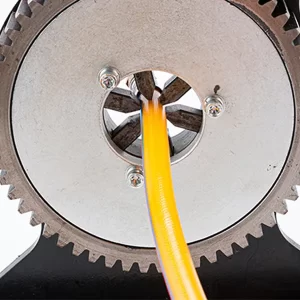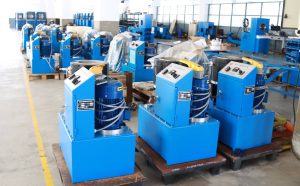Understanding what features to look for in a hydraulic hose crimper is essential for any business dealing with hydraulic hose assembly and maintenance. This article titled “What Features Should You Prioritize in a Hydraulic Hose Crimper?” aims to guide professionals through the critical aspects that determine a crimper’s efficiency, safety, and reliability. But here’s the kicker: selecting the right features can save your operation time, reduce errors, and extend equipment life. We will cover essential mechanical components, safety features, automation, and future innovations, ensuring you make an informed choice that fits your business needs perfectly.
1. What core features define a hydraulic hose crimper?
Hydraulic hose crimpers possess several fundamental features that dictate their performance. At the heart lies a powerful hydraulic pump, responsible for generating the pressure needed to compress fittings securely. Durable die sets custom-made for various hose sizes ensure consistent crimp quality. Robust construction materials like high-grade steel provide longevity and withstand demanding industrial environments. Ready for the good part? These core features guarantee secure, leak-proof connections vital for hydraulic system reliability. Additionally, ergonomic design elements ease operator use, enhancing productivity.
| Feature | Description | Benefit |
|---|---|---|
| Hydraulic Pump | Generates crimping pressure | Consistent, strong crimps |
| Custom Dies | Match hose/fitting sizes | Precision and versatility |
| Construction | Heavy-duty materials | Long service life |
2. Which safety features are vital in hydraulic hose crimpers?
Safety cannot be overstated when operating hydraulic hose crimpers. Critical safety features include emergency stop buttons that instantly halt operations, preventing accidents during malfunction. Pressure relief valves protect both operator and machine from excessive force. Protective guards and sensors detect operator presence or misaligned dies, halting machine activity if hazards arise. This is where it gets interesting: many modern crimpers comply with strict industry standards, ensuring your team works in a safe environment and your liability is minimized.
| Safety Feature | Purpose | Advantage |
|---|---|---|
| Emergency Stop | Immediate shutdown | Accident prevention |
| Pressure Relief | Limits excess force | Protects equipment and users |
| Guards & Sensors | Detect hazards and presence | Enhances operational safety |
3. What role does automation play in modern hydraulic hose crimpers?
Automation revolutionizes hydraulic hose crimping by enhancing precision and productivity. Automated pressure controls allow machines to adjust force based on hose and fitting specifications, reducing human error. Programmable settings enable repeatable crimps at scale, ideal for high-volume production. Data logging records operational parameters, assisting in quality control and predictive maintenance. But here’s the kicker: integrating automation with factory systems streamlines workflows, making hydraulic hose assembly more efficient and cost-effective.
| Automation Feature | Function | Benefit |
|---|---|---|
| Pressure Control | Adjusts force automatically | Consistent quality |
| Programmable Settings | Customizable crimp profiles | High throughput |
| Data Logging | Tracks performance and usage | Maintenance forecasting |
4. How important is die versatility and compatibility?
Die versatility significantly impacts a crimper’s flexibility. Crimpers supporting a wide range of hose sizes reduce the need for multiple machines, saving space and cost. Interchangeable dies enable quick adaptation for different fittings and hose types. This compatibility minimizes downtime during changeovers. What’s the real story? A versatile die system ensures your crimper can handle evolving production needs, making it a future-proof investment.
| Die Feature | Description | Impact |
|---|---|---|
| Size Range | Accommodates various hoses | Reduces machine variety |
| Interchangeability | Quick die swaps | Minimizes downtime |
| Custom Dies | Tailored to fittings | Ensures secure crimps |
5. What operational controls enhance usability?
User-friendly operational controls boost efficiency and reduce errors. Digital interfaces provide clear pressure readouts and easy adjustments, while manual controls offer simplicity for basic tasks. Adjustable cycle speeds help tailor crimping to specific hoses, preventing damage. Additional features like foot pedals or hand switches enhance ergonomics. Ready for the good part? Controls designed with the operator in mind improve workflow speed and reduce training time.
| Control Type | Description | Benefit |
|---|---|---|
| Digital Interface | Displays and adjusts pressure | Precision and ease |
| Manual Controls | Basic, tactile operation | Reliability |
| Adjustable Speed | Variable cycle timing | Protects hoses |
6. How does crimping accuracy affect performance?
Accuracy in crimping directly influences the hydraulic hose’s performance and safety. Precise die alignment ensures uniform compression, preventing leaks or weak points. Regular calibration maintains this precision, avoiding inconsistencies that cause failures. Visual and pressure testing post-crimp verify integrity. This is where it gets interesting: accurate crimps extend hose lifespan and reduce costly downtime due to premature failures or replacements.
| Accuracy Factor | Quality Control Method | Effect |
|---|---|---|
| Die Alignment | Calibration routines | Consistent crimps |
| Compression Force | Automated pressure control | Leak-free seals |
| Post-Crimp Tests | Visual and pressure checks | Ensures reliability |
7. What maintenance features simplify upkeep?
Maintenance-friendly design enhances uptime and reduces repair costs. Easy access panels allow quick hydraulic fluid checks and component servicing. Self-diagnostic systems alert operators to issues before breakdowns occur. Simplified die replacement minimizes downtime during tool changes. But here’s the kicker: machines designed with maintenance in mind save hours of labor, keeping production running smoothly and cutting long-term expenses.
| Maintenance Feature | Description | Advantage |
|---|---|---|
| Access Panels | Easy component reach | Faster servicing |
| Diagnostics | Alerts for faults | Prevents unexpected stops |
| Quick Die Change | Tool-free or simple replacement | Reduces downtime |
8. How do portability and size influence choice?
Portability is crucial for field service or small workshops needing flexibility. Lightweight, compact crimpers can be transported easily to remote sites. Conversely, larger stationary crimpers provide greater power and throughput for high-volume factory environments. What’s the real story? Balancing portability against power requirements ensures optimal equipment use and operational efficiency.
| Crimper Type | Size/Weight | Best Use Case |
|---|---|---|
| Portable | Compact, lightweight | On-site repairs |
| Stationary | Larger footprint | Factory production |
| Hybrid | Medium size | Versatile applications |
9. What power sources are available and how do they impact performance?
Hydraulic hose crimpers operate on various power sources: electric motors, hydraulic pumps, or pneumatic systems. Electric crimpers offer precise control and are common in workshops. Hydraulic-powered models deliver high force for heavy-duty applications. Pneumatic crimpers provide portability with compressed air. Energy efficiency varies, with electric models generally offering lower operational costs. But here’s the kicker: choosing the right power source matches machine capability to application demands, optimizing productivity.
| Power Source | Characteristics | Application |
|---|---|---|
| Electric | Precise, low maintenance | Workshops, medium use |
| Hydraulic | High force, durable | Heavy-duty, high volume |
| Pneumatic | Portable, requires air supply | Mobile repairs |
10. How do software integrations benefit hydraulic hose crimpers?
Software integration enables real-time monitoring, quality control, and predictive maintenance. Connected crimpers transmit data to centralized systems, enabling workflow optimization and early fault detection. User-friendly interfaces simplify parameter adjustments and data management. Ready for the good part? These integrations transform crimpers from standalone tools into smart machines, driving operational intelligence and reducing unexpected downtime.
| Software Feature | Function | Benefit |
|---|---|---|
| Real-Time Monitoring | Tracks machine status | Immediate issue detection |
| Predictive Maintenance | Analyzes wear trends | Prevents failures |
| Data Management | Records production data | Quality assurance |
11. What role does manufacturer support and warranty play?
Strong manufacturer support ensures reliable operation through technical assistance, spare parts availability, and training. Comprehensive warranties protect against defects and extend machine life. Training programs help operators maximize machine capabilities safely. What’s the real story? Selecting vendors with robust support and warranty policies safeguards your investment and keeps your operation running smoothly.
| Support Aspect | Service Provided | Value |
|---|---|---|
| Technical Support | Troubleshooting assistance | Minimizes downtime |
| Warranty | Defect coverage | Reduces repair costs |
| Training | Operator education | Enhances safety and use |
12. How do cost considerations relate to feature selection?
While advanced features add value, balancing cost against operational needs is key. High-end automation and safety increase upfront cost but reduce errors and maintenance. Simpler models offer affordability but may incur higher long-term costs due to slower operation or increased downtime. But here’s the kicker: evaluating total cost of ownership, including training and maintenance, ensures smarter investment decisions.
| Cost Factor | Impact | Recommendation |
|---|---|---|
| Upfront Cost | Initial investment | Balance with needs |
| Maintenance Cost | Ongoing expenses | Prioritize maintainability |
| Productivity Gain | Efficiency improvement | Justifies higher spend |
13. How do industry standards influence feature requirements?
Compliance with ISO, OSHA, and other regulatory standards shapes feature design to ensure safety and quality. Certifications guarantee that crimpers meet strict performance and safety benchmarks. Features like pressure relief valves and operator guards align with these standards. Ready for the good part? Adhering to standards not only avoids legal issues but also boosts customer confidence in your products.
| Standard | Requirement | Feature Implication |
|---|---|---|
| ISO | Quality management | Calibration, testing |
| OSHA | Worker safety | Guards, emergency stops |
| ANSI | Equipment performance | Pressure control |
14. What emerging features are shaping the future of hydraulic hose crimpers?
Future crimpers will feature AI-enhanced automation optimizing pressure and cycle times for various hose types. IoT connectivity will enable seamless integration into smart factories. Energy-efficient designs reduce environmental impact and operating costs. Additive manufacturing allows rapid customization of dies and components. This is where it gets interesting: these trends promise improved productivity, reduced waste, and smarter maintenance strategies.
| Emerging Feature | Description | Potential Impact |
|---|---|---|
| AI Automation | Adaptive crimping control | Enhanced quality |
| IoT Connectivity | Real-time factory integration | Predictive maintenance |
| Energy Efficiency | Reduced power consumption | Cost and environmental savings |
15. How can businesses evaluate feature relevance for their operations?
Assessing production volume, hose types, and budget helps prioritize features that deliver maximum benefit. Consultation with vendors and trial periods provide insight. Operator skill level influences the need for automation or simple controls. But here’s the kicker: a clear understanding of operational goals ensures you invest in a hydraulic hose crimper that aligns perfectly with your unique requirements.
| Evaluation Factor | Considerations | Decision Guidance |
|---|---|---|
| Production Needs | Volume and variety | Determines machine type |
| Budget | Financial constraints | Balances features vs cost |
| Operator Skill | Experience and training level | Influences complexity |
FAQ Section
Q1: What is a hydraulic hose crimper?
A hydraulic hose crimper is a machine designed to securely attach fittings onto hydraulic hoses by compressing metal sleeves, creating leak-proof connections essential for hydraulic systems.
Q2: How does a hydraulic hose crimper work?
It uses hydraulic pressure to compress dies around hose fittings, deforming metal to form a durable mechanical bond.
Q3: What safety features should hydraulic hose crimpers have?
Emergency stops, pressure relief valves, protective guards, and sensors ensure operator safety during use.
Q4: Why is die compatibility important?
Die compatibility ensures the crimper can handle various hose sizes and fitting types, enhancing versatility and reducing downtime.
Q5: How does automation improve hydraulic hose crimping?
Automation improves precision, reduces human error, speeds up production, and provides data for quality control and maintenance.




